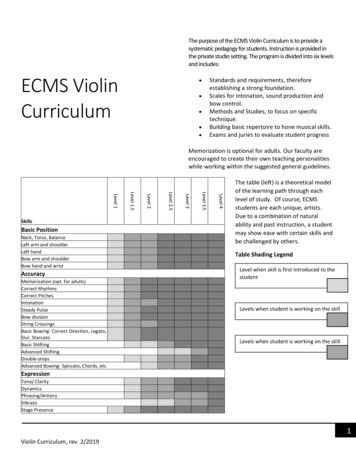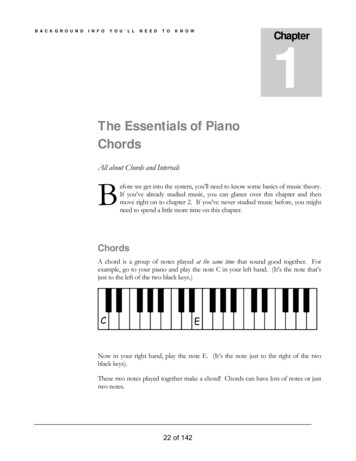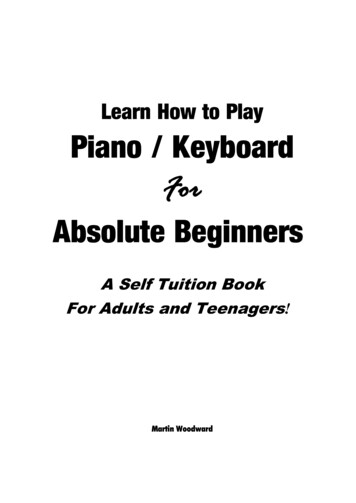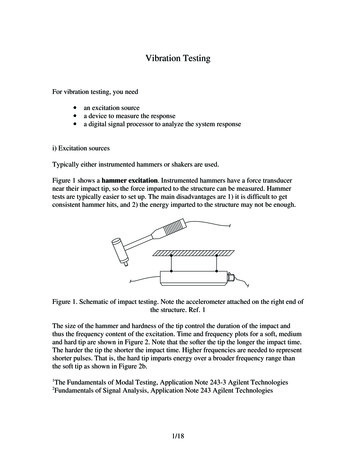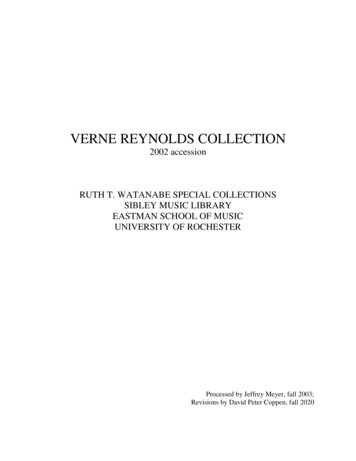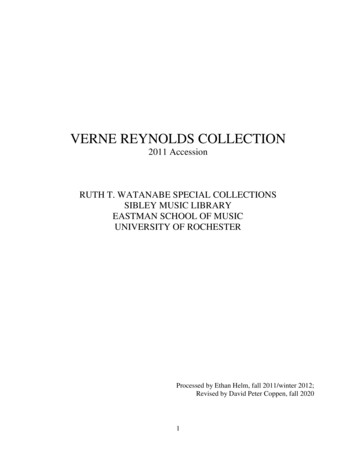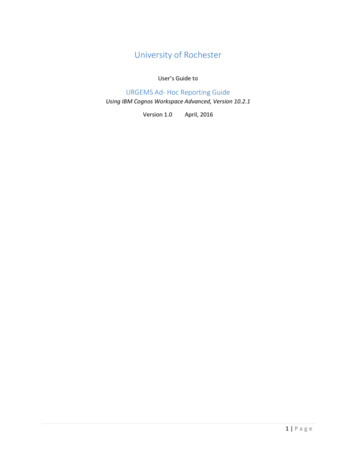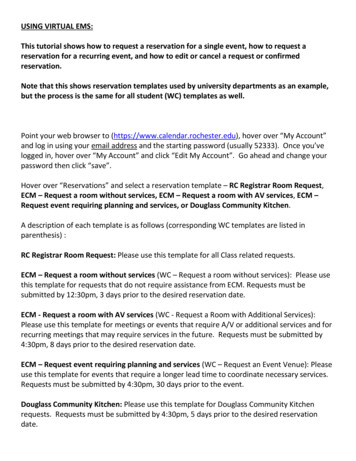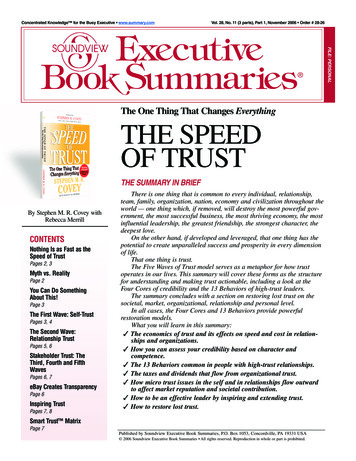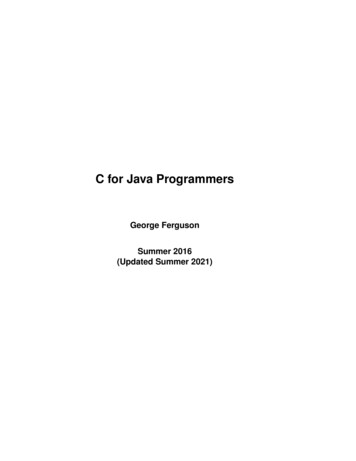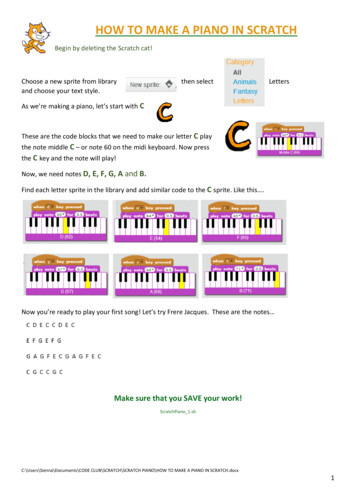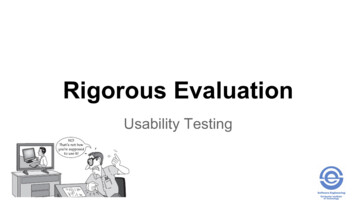
Transcription
Eastman Community Music SchoolPiano Curriculum2013Mission Statement of the Piano DepartmentOur mission is to guide students of all ages in the Art of Piano in ways that areloving and challenging and to represent a standard of quality for the community. Thegoal: to love music.Adopted by the piano faculty, Spring 2000Students and families coming to Eastman for piano lessons have a wide range ofexpectations and ambitions; we can be many things to many people, and we try to helpstudents find their own way in a diverse musical universe. We realize that piano skills arebasic in western music, and our Curriculum attempts to guide students to a mastery ofseveral skill sets in diverse musical styles.This new 2013 edition of the Piano Curriculum revisits the Eastman PianoDepartment Curriculum, which has been in continuous use (with frequent revisions) sincethe founding of the Preparatory Department of the School in 1921.We strongly encourage our piano students to enrich their skills by taking advantageof the many ECMS Theory course offerings. Recognizing that “ear precedes eye” inlearning to play an instrument, we encourage the playing of folksongs by ear in the earlylevels, along with the acquisition of keyboard harmony skills: scales, triads, inversions,and chord progressions. Teachers may adopt diverse exercises involving ear training,singing, and movement; many make use of music theory texts alongside piano methods inthe early grades.Annual examinations provide an ongoing assessment of student progress. ECMSPiano students are strongly encouraged to play annual examinations. We do not formallyexamine piano students in music theory, ear training, or improvisation. The examinationreport consists of written commentary and a numeric rating within the level submitted bythe student’s teacher. Six numeric levels follow the introductory level. Levels 4 through 6are designated by ECMS as “Advanced Division.” Students in these levels will generallybe examined by a jury rather than by an individual teacher.A student is eligible to receive the Community Music School Diploma in Pianowhen he or she achieves at least a 75% score in level 5 and has completed the prescribedcoursework. Most of our piano students, working diligently and consistently, aspire toachieve this grade. For a complete discussion of our Diploma offerings, see the pertinentECMS brochure, or visit the website www.esm.rochester.edu/community .Our Repertoire represents some recommendations; teachers may feel free tochoose other repertoire of similar level in any category. Methods and Collections listedare likewise offered as representative examples.1
ECMS Piano CurriculumIntroductory LevelTechnique and Keyboard SkillsPlay 1 or 2 scales; hands separately, one octave in quarter notes, M.M. 72 – 96.StudiesAlfredBurnamTechnic Books [1A]Dozen a Day [Mini, Preparatory]MethodsAlfredBarrett, CarolBoosey & HawkesBurnamClarkD'AubergeFaber and FaberHal LeonardOlsonSuzukiThompsonPremier Piano Course, 1A-1BChester's Easiest Piano Course Books 1, 2The Russian School of Piano Playing, Book 1Step-by-Step, Book 1Music Tree, Time to Begin, Part 1Piano Course, Book 1Piano Adventures, Primer and Level 1All-In-One Piano Lessons, Books B, C, DMusic Discoveries; Solos Book A, Music PathwaysPiano Method Book 1Teaching Little Fingers to Play; Easiest Piano Course 1, 2ContemporaryLinda NiamathChristopher NortonDonald WaxmanMarching Mice (and others)Connections for Piano, Book 1Introductory Pageant, Book 1; Folksongs Pageant 1ACollectionsHarris (pub.)SnellCelebration Series, Introductory BookKJOS Library Piano Repertoire Series, PreparatoryExamination RequirementsStudent should play a few pieces to demonstrate beginning competency in duple/triplemeters, staccato/legato touch, piano/forte dynamics.2
ECMS Piano CurriculumLevel 1Technique and Keyboard SkillsScales and Arpeggios, each hand one octave up and down, 100. 7 major keys,3 harmonic minors.Tonic and Dominant chords, hands alone or together, in the keys of the scales.EtudesBurnamCzernyCelebration SeriesOlsonA Dozen a Day, Book 1Studies, Op. 823Perspectives Piano Etudes, Book 1Traditional Piano Etudes, Book 1MethodsClark, Goss, HollandFaber and FaberHal LeonardThompsonMusic Tree, Parts 2A, 2BPiano Adventures, Books 2A, 2BPiano Lessons, Books 2, 3Easiest Piano Course, Books 2, 3CollectionsAgayClark et. al.Faber and FaberHarris (pub.)OlsonJoy of 1st Year Piano*Keyboard Literature (Music Tree, Part 3)Developing Artist/Piano Literature; Book 1*Celebration Perspectives Piano Repertoire; Intro., Book 1Essential Keyboard Repertoire, Volume 1Literature by ComposerBartokMikrokosmos, Books 1, 2; First Term at the Piano;For ChildrenGeorge, JonA Day in the Park, A Day in the Jungle, etc.Norton, ChrisMicrojazz for Beginners, Microjazz Collection 1OlsonBeginning SonatinasWaxmanPageants, Book 23
Examination Requirements1. The examiner will ask to hear scales, arpeggios, and chord progressions in one or twokeys. The goal of 7 Major/3 Minor keys is not attainable by all level one students.Metronome is not used in the examination: tempo is a practice guideline.2. The student will play three contrasting pieces. Students may be stopped partwaythrough longer pieces. Examinations are not recitals, and they proceed according toschedule. Students may be assured that at least a portion of each composition will beheard.*Asterisk indicates listing in NYSSMA Level One.4
ECMS Piano CurriculumLevel 2Abstract Technique and Keyboard SkillsScales. Quarter notes and eighth notes, hands separately, M.M. ca. 72.Triad Arpeggios, hand over hand, quarter notes 2 octaves, eighth notes 4 octaves.Minimum 10 major and 5 minor keys (harmonic formI, IV, V chord progressions in 5 major and 5 minor keys. Hands together or separately.EtudesBurnamCzerny-GermerOlson, ed.A Dozen a Day, Books 1 and 2Selected Studies, Book I/1Best Traditional Piano Etudes, Book 1Baroque RepertoireSnellKJOS: J.S. Bach, Selections from Anna Magdalena NotebookBach, C.P.E.*March D Major (Attr. J.S. Bach), BWV Anh. 122(Anna Magdalena Notebook)Bach, J.S.*Minuet G Major, BWV Anh. 116(Anna Magdelena Notebook)Handel, G.F.*Bourrée in G Major; “Impertinence,” HWV 494Petzold, C.*Minuet G Major (Attr. J.S. Bach), BWV Anh. 114*Minuet G Minor (Attr. J.S. Bach), BWV Anh. 115Scarlatti, D.*Minuet C Major, L. 217, K. 73Classic Repertoire (one movement or one dance suffices for examination)Attwood, T.Sonatina in G MajorBeethoven, L.Sonatina in G MajorClementi, M.Sonatina in C Major, Op. 36, no. 1Haydn, J.Six German DancesSpindler, F.Sonatina in C MajorRomantic to Contemporary RepertoireAdler, SamuelGradus, Book 1Bartok, BelaFor Children, Books 1 and 2; Mikrokosmos, Books 1-2Bernstein, Seymour MoodscapesBurgműllerProgressive Pieces, Opus 100Caramia, TonyThe Sounds of Jazz; Six SketchesGeorge, JonDay in the Jungle; Kaleidoscope Books 3-45
GretchaninoffKabalevskyNorton, ChrisShostakovitch, DSchumannWaxman, DCollectionsAgay, ed.Bastien, JamesClark, Goss, HollandFaber and FaberChildren’s Album, Op. 9824 Pieces for Children, Op. 39Microjazz Collection 1; Connections Book 2*Children’s PiecesAlbum for the YoungPageants for Piano, Book 2 / Folksong Pageants, Book 1AHarrisOlsonEasy Classics to Moderns, Vol. 17Sonatina Favorites, Book IMusic Tree Part 3 Keyboard LiteratureDeveloping Artist Library: Piano Lit. Books 1 & 2and Sonatinas, Book 1Celebration Perspectives Piano Repertoire Books 2-3Essential Keyboard Repertoire, Volume 1MethodsHal LeonardClark, Goss, HollandFaber and FaberThompsonPiano Lessons, Books 2, 3, 4Music Tree, Part 3Piano Adventures, Books 3A, 3B, Fun TimeEasiest Piano Course, 3-4Examination Requirements1. Examiner will ask to hear scales, arpeggios, and chord progressions in one or two keys.A metronome is not used in the examination.2. Student should play four contrasting pieces: an etude, a baroque piece, a classicalpiece, and a romantic-contemporary piece.*Asterisk indicates listing in NYSSMA Level Two6
ECMS Piano CurriculumLevel 3Abstract Technique and Keyboard SkillsScales in quarters, eighths and sixteenths, hands separately. All majors and at least 8harmonic minors, M.M. 92.Diminished Seventh Arpeggios, similarly, 72Triad Arpeggios (root position only), quarters and eighths, hands separately, same keysas scales, All keys, 120.Chord Progression I-IV-I-V-I in major and minor keys.EtudesCzerny-GermerHellerSelected Studies, Book I, part 2Studies, Opus 46, 47, 125BaroqueBachHandelShort PreludesVarious short contrapuntal atina in F MajorSonatina in A Minor*Sonatinas, Op. 36, No. 2 – 4Sonatina in G, Op. 20, No. 1Sonatinas, Op. 55Romantic to ContemporaryBartokMikrokosmos, Vol 3GriegLyric PiecesKabalevskyVariations, Op. 51; Children’s Pieces, Op. 27KhachaturianAdventures of IvanLiebermann, L.Album for the YoungNakadaJapanese FestivalPintoScenas InfantisProkofiev*Music for Children, Op. 65Schubertselected easy Ländler, Minuets, WaltzesSchumannAlbum for the Young: Knecht RuprechtStarerSketches in ColorCollections7
Faber and FaberHarrisMyersOlsonVarious ed.Lesson Books 4 – 5; Sonatina bk. 2-3, Developing Artist Bk. 3-4Celebration Perspectives Piano Repertoire Bk. 3, 4, 5, 6Spectrum 2: 30 Miniatures for Solo Piano.Applause, Bk. 1Sonatina AlbumExamination Requirements1. The examiner will ask to hear scales, arpeggios, and chord progressions in one or twokeys. A metronome is not used in the examination: tempos above are given as practiceguidelines.2. The student will play four contrasting pieces: an etude, a baroque piece, a classicalpiece, and a romantic-contemporary piece.* Asterisk indicates inclusion in the 2003 NYSSMA listing, Level 3. We include thisinformation for the convenience of students who wish to play for NYSSMA solofestivals. Be sure to consult the current NYSSMA manual to confirm these listings: theychange from year to year! The NYSSMA catalog uses a 6-level structure, similar to thisCurriculum, but there are relatively few points of congruity between the two lists. Onecan often find appropriate repertoire in the NYSSMA catalog by looking one level aboveor below our corresponding levels.8
ECMS Piano CurriculumLevel 4Abstract TechniqueScalesAll major and harmonic minor scales are to be played hands together, withthe hands one octave apart: up and down 1 octave in quarter notes, 2octaves in eighth notes, 3 octaves in triplets, 4 octaves in sixteenth notes, atabout M.M. 92.ArpeggiosAll diminished sevenths to be played similarly at the same speed; all majorand minor triads to be played in three positions, 1 octave in quarter notes, 2octaves in eighth notes, 4 octaves in sixteenth notes M.M. 80.StudiesBertiniCzerny, ed. GermerStudies, Op. 29Selected Studies, I/2BaroqueBachScarlattiTwo-Part InventionsSelected ons on a Swiss Air, WoO 646 Easy Variations on an Original Theme, WoO 77Sonatas, Op. 49*Sonatinas, Op. 36, No. 5-6Sonatinas, Op. 20, No. 2-3*Viennese Sonatinas; *Sonata in C, K. 545; Sonata in F, K. 547aRomantic to ContemporaryAdlerGradus IIAlbeniz6 Spanish DancesBartókMikrokosmos [III, IV]S. BernsteinBirds; Moodscapes; InsectsBlochEnfantinesCasella11 Pieces EnfantinesChopinMazurkas: Op. 7, No. 1-2 (B-flat, a); Op. 67, No. 2, 4 (g, a);Op. 68, No. 3 (F).Nocturnes: Op. 15, No. 3 (g); Op. 55, No. 1 (f); Op. Posth. (c).Polonaises: Op. Posth. B-flat and g.Preludes: No. 4 (e), No. 6 (b), No. 7 (a).Waltzes: Op. Posth. a.CoreaChildren's SongsCreston5 Little Dances; 5 Dances Op. 1DebussyArabesque No. 1; Le Petit Negre9
welve Spanish DancesLyric PiecesVariations, Op. 51; 2 SonatinasAdventures of IvanWoodland Sketches; Fireside Tales; New England IdyllsSongs Without Words (easier ones); Children’s Pieces, Op. 72Scenas InfantisMusic For Children, Op. 65 (level 3-4)German Dances and Waltzes (easier ones)Preludes, Op. 11, No. 2, 4, 15, 17, 22Sketches in Color; 7 Vignettes; HexahedronPour Les Enfants; Happy Time ICollectionsAgay, ed.HarrisMyersOlsonSonatina AlbumsClassics to Moderns Vol 37 "Music for Millions”Celebration Perspectives Piano Repertoire books 5,6,7,8Spectrum and Spectrum 3: Contemporary Works for Solo PianoApplause, Book 2Examination RequirementsLevel 4 examinations will generally be played for a jury of teachers, including the pianodepartment chairperson.1. Examiner will ask to hear scales, arpeggios, and chord progressions in one or two keys.A metronome is not used in the examination: tempos above are given as practiceguidelines.2. Student will play four contrasting pieces: an etude, a baroque piece, a classical piece,and a romantic-contemporary piece.*Asterisk indicates listing in NYSSMA Level Four.10
ECMS Piano CurriculumLevel 5Abstract TechniqueScalesAll major scales are to be played in thirds, sixths, and tenths, 1 octave inquarter notes, 2 octaves in eighth notes, 3 octaves in triplets, 4 octaves insixteenth notes, M.M. q circa 100. All harmonic minor scales are to beplayed with hands an octave apart with the same rhythmic subdivisions andat the same tempo.ArpeggiosAll triads are to be played similarly, in three positions, hands together, oneoctave apart, M.M. q circa 100. All Dim. 7 arpeggios are to be playedsimilarly at the same speed. All V7 arpeggios are to be played in rootposition, inversions optional, 1 octave in quarter notes, 2 octaves in eighthnotes, 3 octaves in triplets, 4 octaves in sixteenth notes, M. M. q circa aydnMozartStudies, Op. 89 [for the left hand]The School of Velocity, Op. 299French SuitesSinfoniasSonatas Op. 2, No. 1 (c); Op 14, No. 1 (E)Rondos, Op. 51Sonatas Hob. XVI No. 23 (F), 27 (G), 35 (C), 37 (D),40 (G), 44 (g)Sonatas K. 282 (Eb), 283 (G), 330 (C), 332 (F)Fantasie in D minor, K. 397Romantic to pin (cont’d.)Album of 8
Thompson Easiest Piano Course, 3-4 Examination Requirements 1. Examiner will ask to hear scales, arpeggios, and chord progressions in one or two keys. A metronome is not used in the examination. 2. Student should play four contrasting pieces: an etude, a baroque piece, a classical piece, and a romantic-contemporary piece. *Asterisk indicates listing in NYSSMA Level Two . 7 ECMS Piano .
